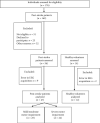Intrahemispheric EEG: A New Perspective for Quantitative EEG Assessment in Poststroke Individuals
- PMID: 34603441
- PMCID: PMC8481048
- DOI: 10.1155/2021/5664647
Intrahemispheric EEG: A New Perspective for Quantitative EEG Assessment in Poststroke Individuals
Abstract
The ratio between slower and faster frequencies of brain activity may change after stroke. However, few studies have used quantitative electroencephalography (qEEG) index of ratios between slower and faster frequencies such as the delta/alpha ratio (DAR) and the power ratio index (PRI; delta + theta/alpha + beta) for investigating the difference between the affected and unaffected hemisphere poststroke. Here, we proposed a new perspective for analyzing DAR and PRI within each hemisphere and investigated the motor impairment-related interhemispheric frequency oscillations. Forty-seven poststroke subjects and twelve healthy controls were included in the study. Severity of upper limb motor impairment was classified according to the Fugl-Meyer assessment in mild/moderate (n = 25) and severe (n = 22). The qEEG indexes (PRI and DAR) were computed for each hemisphere (intrahemispheric index) and for both hemispheres (cerebral index). Considering the cerebral index (DAR and PRI), our results showed a slowing in brain activity in poststroke patients when compared to healthy controls. Only the intrahemispheric PRI index was able to find significant interhemispheric differences of frequency oscillations. Despite being unable to detect interhemispheric differences, the DAR index seems to be more sensitive to detect motor impairment-related frequency oscillations. The intrahemispheric PRI index may provide insights into therapeutic approaches for interhemispheric asymmetry after stroke.
Copyright © 2021 Rodrigo Brito et al.
Conflict of interest statement
The authors report no conflicts of interest.
Similar articles
-
How does upper extremity Fugl-Meyer motor score relate to resting-state EEG in chronic stroke? A power spectral density analysis.Clin Neurophysiol. 2019 May;130(5):856-862. doi: 10.1016/j.clinph.2019.01.007. Epub 2019 Feb 2. Clin Neurophysiol. 2019. PMID: 30902439
-
Are early measured resting-state EEG parameters predictive for upper limb motor impairment six months poststroke?Clin Neurophysiol. 2021 Jan;132(1):56-62. doi: 10.1016/j.clinph.2020.09.031. Epub 2020 Nov 3. Clin Neurophysiol. 2021. PMID: 33248434
-
Is Resting-State EEG Longitudinally Associated With Recovery of Clinical Neurological Impairments Early Poststroke? A Prospective Cohort Study.Neurorehabil Neural Repair. 2020 May;34(5):389-402. doi: 10.1177/1545968320905797. Epub 2020 Apr 4. Neurorehabil Neural Repair. 2020. PMID: 32249674
-
Quantitative electroencephalography to assess post-stroke functional disability: A systematic review and meta-analysis.J Stroke Cerebrovasc Dis. 2024 Dec;33(12):108032. doi: 10.1016/j.jstrokecerebrovasdis.2024.108032. Epub 2024 Sep 30. J Stroke Cerebrovasc Dis. 2024. PMID: 39357611
-
A systematic review investigating the relationship of electroencephalography and magnetoencephalography measurements with sensorimotor upper limb impairments after stroke.J Neurosci Methods. 2019 Jan 1;311:318-330. doi: 10.1016/j.jneumeth.2018.08.009. Epub 2018 Aug 14. J Neurosci Methods. 2019. PMID: 30118725
Cited by
-
Sensory and motor cortical excitability changes induced by rTMS and sensory stimulation in stroke: A randomized clinical trial.Front Neurosci. 2023 Jan 25;16:985754. doi: 10.3389/fnins.2022.985754. eCollection 2022. Front Neurosci. 2023. PMID: 36760794 Free PMC article.
-
Review of Noninvasive Neuromonitoring Modalities in Children II: EEG, qEEG.Neurocrit Care. 2023 Dec;39(3):618-638. doi: 10.1007/s12028-023-01686-5. Epub 2023 Mar 22. Neurocrit Care. 2023. PMID: 36949358 Free PMC article. Review.
-
Interhemispheric Facilitatory Effect of High-Frequency rTMS: Perspective from Intracortical Facilitation and Inhibition.Brain Sci. 2022 Jul 23;12(8):970. doi: 10.3390/brainsci12080970. Brain Sci. 2022. PMID: 35892411 Free PMC article.
-
Can electroencephalography (EEG) identify the different dimensions of pain in fibromyalgia? A pilot study.BMC Musculoskelet Disord. 2024 Sep 3;25(1):705. doi: 10.1186/s12891-024-07824-0. BMC Musculoskelet Disord. 2024. PMID: 39227893 Free PMC article.
-
Sub-Scalp Implantable Telemetric EEG (SITE) for the Management of Neurological and Behavioral Disorders beyond Epilepsy.Brain Sci. 2023 Aug 8;13(8):1176. doi: 10.3390/brainsci13081176. Brain Sci. 2023. PMID: 37626532 Free PMC article. Review.
References
-
- WHO. WHO | The Atlas of Heart Disease and Stroke . WHO; 2010.
-
- Nowak D. A., Grefkes C., Ameli M., Fink G. R. Interhemispheric competition after stroke: brain stimulation to enhance recovery of function of the affected hand. Neurorehabilitation and Neural Repair . 2009;23(7):641–656. - PubMed
-
- van Meer M. P. A., van der Marel K., Wang K., et al. Recovery of sensorimotor function after experimental stroke correlates with restoration of resting-state interhemispheric functional connectivity. Journal of Neuroscience . 2010;30(11):3964–3972. doi: 10.1523/JNEUROSCI.5709-09.2010. - DOI - PMC - PubMed
-
- Murase N., Duque J., Mazzocchio R., Cohen L. G. Influence of interhemispheric interactions on motor function in chronic stroke. Annals of Neurology . 2004;55(3):400–409. - PubMed
Publication types
MeSH terms
LinkOut - more resources
Full Text Sources
Medical


